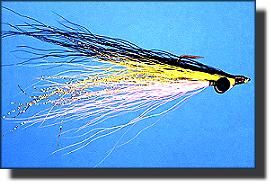Clouser Minnow
By Al Campbell
The Clouser Minnow is perhaps the most effective streamer fly
of all time. It catches anything that will eat a minnow. In fact, it usually
out-fishes any other streamer pattern you might have hidden in your
fly box. Aside from the common jig, it is likely the most productive
single lure of all time. For that, we need to thank Bob Clouser for his
inventive mind and this great fly.
I believe a Clouser Minnow will catch anything that opens its
mouth. To date, I've caught three kinds of bass, walleyes, northern
pike, tiger musky, five types of trout, two types of catfish, carp,
crappie, perch, bluegills and sunfish on the fly. I also had the luck to
catch a few unnamed saltwater fish and something called a surf-perch
when I had the rare chance to try it in saltwater. Can you name
another fly that's versatile enough to catch more species of fish?
I think the greatest feature of the Clouser Minnow is the way the
barbell eyes cause the fly to "swim" in the water. You have some
control over this motion by having control over where you place the
eyes. Move them forward toward the hook eye and it swims more like
a jig. Move them back toward the hook bend, and it glides through the
water.
Traditionally, the eyes are tied to the hook about 1/3 of the hook
shank back from the hook eye. This causes the fly to swim similar to a
jig with a slight sliding motion. When I tie the fly for chasing crappie, I
usually move the eyes to about 1/4 of the hook shank back from the
hook eye. This causes the fly to dip and dive very much like a
traditional crappie jig. For smallmouth bass, I often tie in the eyes
between 1/3 and 1/2 the hook shank back from the hook eye to create
a sliding motion smallmouth bass just can't resist.
Another feature of the Clouser Minnow is the way the fly swims
with the hook point up instead of the traditional downward look. This
makes the fly virtually weedless so it can be used in heavy cover
where many predator fish lurk. It also does a pretty good job of
bouncing over rocks without hanging up or damaging the point of the
hook.
For those folks who don't believe walleyes can be caught on a
fly, they just don't know the value of a Clouser Minnow. This is one
of the most productive walleye lures ever invented. Fished in the
shallows in spring and fall, it often out-fishes more traditional lures and
baits. Fished off rocky points and drop-offs during the hot days of
summer, it's often just the thing big walleyes are looking for.
If you look closely at minnows and other water critters like
crayfish, you'll notice that the underside of these creatures is lighter in
color than the top. It's important to consider this fact when you place
the materials on the hook. Since this fly swims with the hook point up,
the lighter materials are placed on the opposite side of the hook shank
from the point. This is exactly the opposite from the way most
streamers are tied.
Although I could probably consume a few more pages of text
describing the virtues of the Clouser Minnow, I think I'll let you find
out for yourself instead. Let's get started.
Materials: Clouser Minnow
Hook: Mustad 3407, Tiemco 811S
or equivalent. Sizes 2/0 to 10.
Thread: 3/0 monocord, color to
match body or create desired effect.
Body: A mix of bucktail, synthetic hair, crystal flash, flashabou
and many other possible things, color to match the natural you want to
match.
Eyes: Non-toxic hourglass eyes, lead barbell eyes,
bead-chain eyes or any similar eyes that add weight.
Tying Steps:
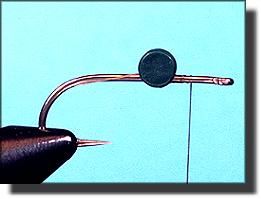
1. Lay down a thread base. Tie a small cluster of crystal flash fibers
to the hook securing the fibers slightly past the beginning of the hook bend
(12 to 24 strands depending on hook size and how bulky you want the fly
to be). Trim the crystal flash to extend 1/3 to 1/2 the hook shank length
past the bend of the hook.
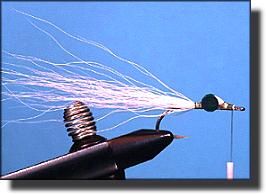
2. Tie the lightest hair or material you're planning on using (in this
case white bucktail) first behind the hook eye, then behind the eyes as
shown. The hair should be pulled tight between the eyes before it's
finally secured.

3. Remove the hook from the vise, turn it over and place it back in
the vise with the point up.
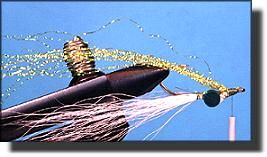
4. Tie in a small patch of crystal flash or flashabou in the desired
color behind the hook eye.
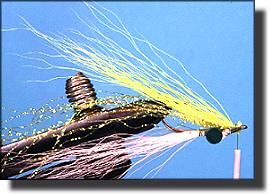
5. Add another patch of hair in the desired color; again, behind the
hook eye.
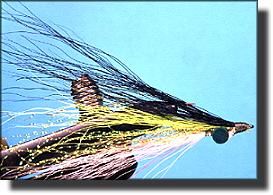
6. Add a darker patch of hair, create a smooth head, whip finish and
cement. (You can add more colors if desired, but keep the hair
relatively sparse.)
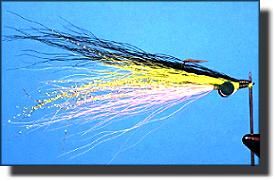
7. When pulled through the water, the hook should ride with the point
up like this.
One final note; you're probably going to need a lot of these flies
so tie up some sturdy spares. If you try them on trout or bass, be sure
to hang onto your rod real tight. The fish get pretty savage when they
try to eat this fly. ~ Al Campbell
|

